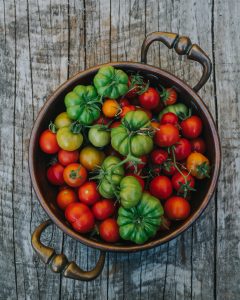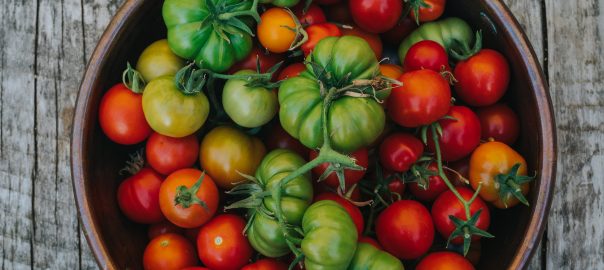Grow Me Now!
August
Tempted by Tomatoes!
They’re the summer favourite that gets gardeners talking – and the one plant, more than any other, that sees a grower invest in a tunnelhouse. Which makes it even more unbelievable that this South American native once aroused so much suspicion when first introduced to Europeans, that they had to be persuaded to eat it! Today, the popularity of the tomato continues to grow, and the trend, over the last few years, toward planting heritage tomatoes, has only increased excitement about the fruit. While Kiwis in cooler regions grow their tomatoes under cover, those in warmer climes are often turning to crop tunnels to provide a well-protected, blemish-free crop.
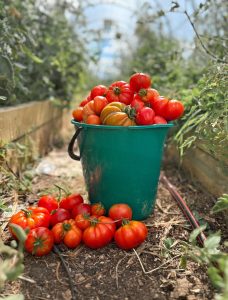
Source
The depths of winter may not feel like the time of year to be germinating tomato seed, but unless you want to be buying seedlings at the garden centre (where there is limited choice of variety) August is certainly the month to start sowing. When choosing seed, there are a few decisions to be made. Tomatoes fall into two broad categories: indeterminate (vine-style) and determinate (bush-style) plants (both are suitable for a tunnelhouse or crop tunnel). Within these two categories, both commercial and heritage tomato varieties are available. The garden centre will be able to supply you with seed of regular tomatoes, and a few heritage varieties, but for more exotic choices, check out Kings Seeds, Koanga Institute, and Trade Me. Or ask around on Facebook gardening groups.
Ground work
Sow your seed into a punnet of quality seed raising mix placed on a sunny window ledge or propagation pad. Tomatoes prick out easily, so once the seeds have germinated, and have their first true leaves (rather than their ‘germination leaves’), transplant them into individual containers of tomato potting mix. Be guided in container size by your climate, and the indoor or propagation space you have available. (In cooler parts of the country, it will still be too cold to place the seedlings in the tunnelhouse in September, or even October, and they may need to grow on, indoors, for several weeks. Make sure their pots give them the root space they will require.)
Once your tomato seedlings are growing, it’s time to prepare your tunnelhouse to receive them. Tomatoes can be in the ground for 6 months or more so it’s important to pile in the nutrients from the start. Dig in plenty of quality compost (a source of nitrogen, but also of the potassium and phosphorus, on which tomatoes thrive). If your compost hasn’t included kelp, add it to the soil, now. Tomatoes prefer a pH of 5.5-6.5, so don’t add lime to the ground unless it is particularly acidic (a soil test kit can help establish this). The roots of tomato plants are shallow, but long, and stretch out horizontally. They don’t enjoy negotiating obstructions, so mix all your ingredients into the bed of the tunnelhouse well, and crumble up any lumpy material. Water the bed deeply, at least twice before planting, and keep it weed-free.
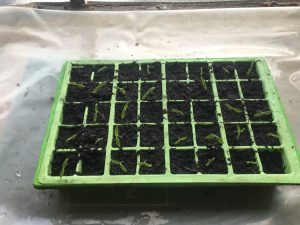
Transplanting
Tomatoes can go into the greenhouse anytime from late August onwards, depending on where in the country you live. If your location is prone to frost then plant in the tunnelhouse late October or even November, especially if the weather is cooler. When transplanting, use a trowel to create pockets 70cm to 90cm apart. If using stakes (rather than twine) as supports, push them into the soil beside the holes before you plant, so you don’t disturb roots. Water each planting hole well, upend the seedling container to ease out the tomato plant, and place the seedling gently in the hole. Lightly firm the soil around the base of the plant (note: you are unlikely to kill a tomato seedling by planting it too deeply, so if your plant is ‘leggy,’ set it down further in the hole, for added support).
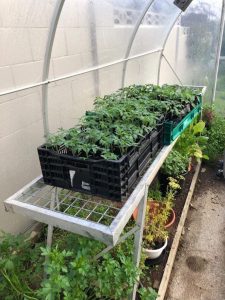
Maintenance
As your tomato plants grow, water them deeply once or twice a week. (This encourages the roots to grow down to cooler soil. More frequent, shallow watering, only encourages roots to invade the surface area, which quickly leads them to over-heat and dry out in hot weather.) Water the plants with a liquid feed of kelp and sterile animal manure every 7-10 days until flowering commences. After that, water with liquid kelp only (too much nitrogen encourages foliage at the expense of flowers).
Unless you are growing grafted tomatoes (in which case refer to the growing instructions that came with them), remove the lateral shoots from indeterminate (vine) tomatoes to encourage the plants to grow up, rather than out, and to hasten flower production. Tie the vines to stakes, or guide them around twine supports, as required. Determinate (bush) tomatoes will also require support. Provide it in the form of a framework or tomato cage.
Keep a watch for sap-sucking insects such as aphids, and squash them with your fingers in the first instance. If the pests persist, apply a spray made from 1/4 tsp hard bathroom soap dissolved in half a litre of boiling water that has been left to cool completely. Repeat every 3-4 days. Note: if you are growing organically, there is no need to completely rid the plants of pests – a healthy balance is what you are aiming for because the general strength of the plants means they can hold their own against a degree of pest attack.
Keep the tunnelhouse well ventilated day and night, promptly snip off any leaves that attract disease, this will also help with airflow and light transmission and harvest fruit as soon as it is ripe to take the pressure off the plants.
Tips
Some gardeners like to grow their tomatoes in fresh soil each season, but if disease hasn’t been a problem in the previous season, you may decide this isn’t necessary.
Always try to grow your own tomatoes from seed. To buy at the garden centre is to risk bringing aphids, white fly and other pests into your tunnelhouse.
When sowing seed, cover the seed containers with a sheet of perspex or glass to prevent mice digging them up (in August, rodents are on the hunt for any food they can find).
If raising seed without the aid of a germination pad, try popping the seed containers inside a plastic bag as they sit on a sunny window ledge. Leave one end of the bag open to avoid over-heating and ‘cooking’ the seed. This mini greenhouse effect can hurry along germination.
As soon as you start sowing tomato seed, begin soaking kelp and sterile animal manure in a large barrel of water. This will be the liquid feed for your plants until flowering time commences.
Tomatoes that are indeterminate love to grow in height. Use your top aluminium purlin in the Tunnelhouse as a support to tie you strings on and these can be adjusted as the plant grows. A simple tent peg or similar at the base of the plant can be used to tie the string on and wind around the stem of the plant as it grows.
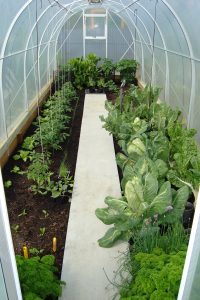
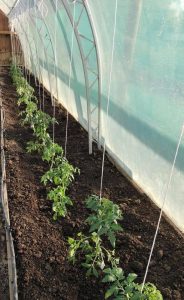
Once you discover a variety of tomato that you favour, keep the seed from it for sowing again next season. To collect seed, take pulp (containing seed) from a ripe tomato, and smear it onto a folded paper kitchen towel. Leave it to dry thoroughly over a period of days, then snip up the individual seeds (paper towel and all) and store in a sealed envelop or jar (don’t forget to label with the date and description).
